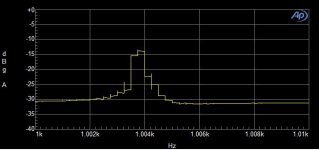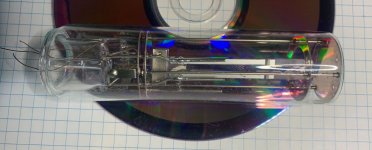How about a classic peak detector coupled to a CDs cell or LDR?
-Chris
I not have good knowledge here, so I ask.
Very interesting design. I didn't know crystals were available at such low frequencies.
If I interpret correctly, the crystal network is parallel resonant. I wonder if Vicktor's design
could be adapted with the xtal in the feedback of the right-hand opamp? The Q is so high that ALC compensation might be a challenge.
Looks like fun. Enjoy!
10k resistors are load resistors. There is a non balanced schematic included in MC12 and it works, I just made it balanced same as my DAC clock.
I have seen 1 KHz crystals, and I might even have one. They are huge! Very vibration sensitive.
I have overloaded and broken a 1kHz crystal in the middle of the night
 and a 4kHz fell off the table.
and a 4kHz fell off the table. 
Anybody who wants to try that needs take care, start with small load resistors below 10k, increase in 1k steps, startup is very slow, can be 2 minutes before anything is visible. If you hear the crystal singing, amplitude is near what is not safe anymore.
..Any ideas and suggestions for amplitude stabilization ?
"Meacham's bridge stabilized oscillator
"1938. The circuit was described as having very high frequency stability and very pure sinusoidal output."
Wien bridge oscillator - Wikipedia
I think there must be a very small signal over the crystal. Otherwise, significant harmonics may appear. Finally, the question will arise, what preferences can we get?Low frequency "relaxation" crystal oscillator.
I used 1kHz and 4 kHz crystals.
Any ideas and suggestions for amplitude stabilization ?
I have seen 1 KHz crystals, and I might even have one. They are huge! Very vibration sensitive.
Well, vibration is the main feature of a vibrator like this ..
"Meacham's bridge stabilized oscillator
"1938. The circuit was described as having very high frequency stability and very pure sinusoidal output."
Injection-Lock a Wien-Bridge Oscillator | Analog Devices
https://www.analog.com/media/en/technical-documentation/application-notes/an43f.pdf
Fig. 35
Patrick
Last edited:
I think there must be a very small signal over the crystal. ...
Yes, but the usual distortion is from using the tube (or whatever) as a clipper to limit and stabilize amplitude.
Meacham realized this and devised a non-clipping stabilization scheme. (H and P got famous for this as applied to R-C audio.)
I think there must be a very small signal over the crystal. Otherwise, significant harmonics may appear. Finally, the question will arise, what preferences can we get?
Actually the crystals are very fragile and too much drive will break them. A good AGC is critical for performance from a crystal oscillator There are a number of circuits for this at RF frequencies: Low Phase Noise Crystal Oscillators For audio frequencies anything from a Jfet to analog multiplier to variable gain amplifier (variation on analog multiplier) would work. There are speedup tricks to get it started more quickly. At 1 KHz the usual diode+cap needs a long time constant so sample and hold techniques are a good alternative.
Still the really high Q and good low noise circuitry around them would yield a good oscillator. Not necessarily low harmonic distortion however. Even really well done XO's have significant 2nd harmonic at RF.
Hi Euvl,
Forgot about that app note, thank you!
Hi Demian,
Yes, they are very fragile. Even mechanical shock for these ones are an issue. I found it was too sensitive to vibration even after using soft rubber shock mounts from a CD mechanism. Never got to the point where I was looking at harmonic content.
-Chris
Forgot about that app note, thank you!
Hi Demian,
Yes, they are very fragile. Even mechanical shock for these ones are an issue. I found it was too sensitive to vibration even after using soft rubber shock mounts from a CD mechanism. Never got to the point where I was looking at harmonic content.
-Chris
Low frequency crystals have large series resistance on resonance. Here is a frequency responce with 100k load. I have few 1kHz tuning forks, let me know if you would like to play with them.
http://www.nkg.com.hk/pdf/NKG-TIT_TuningForkCrystals.pdf
http://www.nkg.com.hk/pdf/NKG-TIT_TuningForkCrystals.pdf
Attachments
Last edited:
Low frequency crystals have large series resistance on resonance. Here is a frequency responce with 100k load. I have few 1kHz tuning forks, let me know if you would like to play with them.
http://www.nkg.com.hk/pdf/NKG-TIT_TuningForkCrystals.pdf
The crystals in that PDF seem to go down to 30kHz only ?
Did you measure by yourself ?
The quartz you have is cut out in the middle ?
All my crystals are plain bars.
Last edited:
Yes and they have series resistance 100k. The tuning forks I have came from different manufacturer: QK Type 30The crystals in that PDF seem to go down to 30kHz only ?
Yes, series resistance ~300kDid you measure by yourself ?
Yes, this is tuning fork, see pages 5,6The quartz you have is cut out in the middle ?
This is a nice chart and summary. It would be nice if there were several JFET op amps. The only FET op amp is the OPA 1656, which is a CMOS op amp. It is a marvelous accomplishment as an op amp. While its noise at 1 kHz is quite low, it has a quite high 1/f noise corner frequency, which is often the case for MOS transistors.
Cheers,
Bob
Cheers,
Bob
The OPA1656 is an exception as it is used for Viktor's 1 kHz oscillator. The OPA1656 is best suited for this application.
- Home
- Design & Build
- Equipment & Tools
- Low-distortion Audio-range Oscillator


